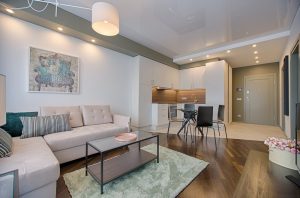The Perfect Blend: Stylish and Functional Interior Design
Creating an interior space that marries style and functionality can be a thrilling adventure in the world of interior design. Who says you have to compromise one for the other? Let’s look at how you can have the best of both worlds, combining stylish aesthetics with practical functionality to create a living space that is not only visually appealing but also perfectly suited to your needs.
 The Importance of Stylish and Functional Design
The Importance of Stylish and Functional Design
Style and functionality are not opposing forces; they can and should complement each other. A beautiful interior that lacks practicality can be frustrating to live in, while a functional but uninspiring space may leave you feeling unfulfilled. The ideal design strikes a balance, catering to your lifestyle and aesthetic preferences.
- Define Your Design Goals
Start your design journey by defining your goals. What do you want to achieve with your interior design? Think about your lifestyle, needs, and preferences. Are you looking to create a cozy, family-friendly space or a sleek, minimalist haven? Your design goals will guide your choices throughout the process.
- Create a Functional Layout
The foundation of a functional interior design is a well-thought-out layout. Consider how you use the space and arrange furniture and accessories to accommodate those activities. Keep traffic flow in mind and ensure that each area serves its intended purpose.
- Choose the Right Furniture
Invest in furniture that is both stylish and practical. Look for pieces that suit your design aesthetic while providing the functionality you need. Consider multi-functional furniture like a sofa bed, a storage ottoman, or a dining table with extendable leaves.
- Optimize Storage
Effective storage solutions are the backbone of a functional interior. Consider built-in shelving, hidden cabinets, or open shelves to keep your space organized and clutter-free. Design your storage to be both functional and stylish, integrating it seamlessly into the overall design.
- Select a Cohesive Color Scheme
A thoughtfully chosen color scheme can enhance both the style and functionality of a space. Bright, light colors can make a small room feel more spacious, while warm, cozy hues can add comfort. A balanced color palette can set the tone for your interior design.
- Layer Lighting
Lighting is a crucial aspect of both style and function. Layer your lighting to create the right ambiance for different activities. Use a combination of ambient, task, and accent lighting to illuminate your space effectively and enhance its aesthetic appeal.
- Consider Textures and Fabrics
Texture and fabrics can add depth and comfort to your interior design. Incorporate a variety of textures like wool, silk, or wood to create visual interest. Choose fabrics that are not only beautiful but also durable and easy to clean, especially in high-traffic areas.
- Integrate Nature
Bringing the outdoors in can enhance your interior’s style and functionality. Indoor plants not only add a touch of nature but also improve air quality. Select low-maintenance plants if you’re not a green thumb, or use artificial options for the same visual effect.
- Balance Open Spaces
Open-concept designs have gained popularity, but it’s essential to maintain a balance between open spaces and defined areas. Use furniture, area rugs, or room dividers to create zones within an open layout, preserving both style and function.
- Personalize with Accessories
Accessories are an opportunity to infuse your personality and style into your interior. Select art, decorative objects, and textiles that resonate with you. These personal touches can make your space feel truly yours.
- Pay Attention to Durability
Consider the durability of your design choices. Opt for materials and finishes that can withstand daily wear and tear. This is especially important in high-traffic areas or homes with kids and pets. Durable design elements can look good and last for years.
- Embrace Minimalism
Minimalism is a design philosophy that places equal emphasis on style and functionality. It encourages you to declutter your space, focusing on quality over quantity. A minimalist design offers a sense of calm and order while remaining visually appealing.
- Emphasize Comfort
Comfort is essential in any interior design. Incorporate comfortable seating, soft textiles, and ergonomic furniture to ensure that your space is inviting and practical. A comfortable space is one you’ll want to spend time in.
- Regularly Edit and Adjust
As your lifestyle changes, so do your design needs. Regularly edit and adjust your space to keep it in line with your current requirements and aesthetics. This flexibility ensures that your interior remains stylish and functional over time.
The perfect blend of style and functionality is attainable with a thoughtful and well-executed interior design plan. Start by defining your design goals, creating a functional layout, and choosing the right furniture. Optimize storage, select a cohesive color scheme, and layer your lighting for added ambiance. Consider textures and fabrics, integrate natural elements, and strike a balance between open spaces and defined areas. Personalize your space with accessories and prioritize durability for a long-lasting design.
Embrace minimalism, emphasize comfort, and don’t forget to regularly edit and adjust your design as needed. The result will be an interior that not only looks stunning but also caters to your unique lifestyle and needs, creating a harmonious, functional, and stylish living space.







